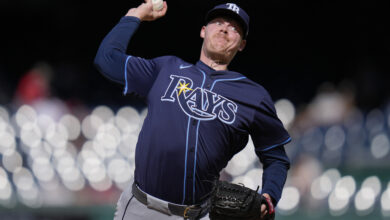
Will Cubs’ $100 Million Rotation Gamble Eventually Pay Off?
We measure our age by trips around the sun. Conversely, the baseball season can be measured by much shorter turns of a rotation. Thirty-two to be precise, plus a few extra starts. With the Cubs’ No. 1 starter, Jon Lester, taking the bump Wednesday night for the second time, that means this season is now has only 31 more turns to come.
Then again, we’re not really through a full turn since the Cubs’ second-most-effective starter from last season hasn’t even made a start yet. That would José Quintana, who struck out eight and yielded “just” two runs in four innings of emergency relief on Saturday.
The Cubs’ official starters have handled just 18 innings in four games, or 4.5 innings per start. This represents nearly one inning less than their average of 5.4 innings per start last year, which wasn’t very good. So depending on expectations of the group and how you spin the stats, this either deepens or blunts your surprise.
That performance really needs to improve, if for no other reason than the Cubs have $101 million invested this year in their rotation pieces. This includes $2.4 million for Mike Montgomery, who made 33 starts over the previous two seasons, and $13.5 million in failed fifth starter Tyler Chatwood.
Of course, time through the rotation does not a whole season make and it would be silly to expect this first turn to mirror the rest. But it’s worth noting that the only team in baseball anywhere near the Cubs’ investment in starters is the Washington Nationals. They too have $101 million locked up in their rotation plus one depth piece, including a whopping $93.3 million for their top three starters: Max Scherzer, Patrick Corbin and Stephen Strasburg.
It is also worth noting that two of those (Scherzer and Corbin) are coming off prime seasons, and the third (Strasburg) had a typical season for him of cautiously meted-out starts to keep him fresh for a playoff run that never came. Even with that caution, the Nationals’ starters averaged nearly an inning more per start than the Cubs’ last year, and that’s before adding Corbin and his 200 IP.
So far this year, the Nationals have eased into the season by averaging six innings per start and a 3.28 ERA. Of the Cubs’ seven theoretical starters, four presently have ERAs of 9.00 or higher. Plus, the Cubs’ five principal starters have so far averaged exactly one walk per inning and have surrendered a home every three innings.
By any measure in hindsight, the Cubs’ $101 million — 48% of the team’s current payroll — has been incredibly poorly spent. Whether or not you agree with Tom Ricketts’ claims that there’s no more money, the rotation’s cost more than anything has precluded investing in any number of other need areas. These include a healthy closer, a dominant setup man, a quality defense-first backup catcher, a veteran contact bat, and perhaps a late-inning defensive upgrade in left field.
To see the how this frustrating situation came about, let’s flip the calendar back 33 big turns of the rotation. Many will point to Yu Darvish and his six-year, $126 million contract as the original sin, but I can’t blame the Cubs front office too much for that one. The strategy was sound and the AAV reasonable, even if the results currently confound. Plus, the Darvish contract did not block the Cubs from additional moves.
But the Chatwood deal certainly did. Rather than address the offense and leadership void by signing proven veteran gamer Lorenzo Cain, the Cubs focused on out-bidding the market by shelling out $13 million a year for a fifth starter who couldn’t even keep his rotation spot in Colorado. A month later, Milwaukee signed Cain for $16 million a year. Ouch.
Then this past offseason – while presumably knowing their extreme budget limitations – the Cubs blew nearly their entire winter bankroll to pick up the $20 million option on Cole Hamels’ age-35 season. There’s a saying that goes, “There are no bad one-year deals in baseball,” but this should be amended to include “unless it precludes any other roster upgrades.”
I’m on record as wishing the Cubs had invested that salary on Andrew McCutchen, maybe Yasmani Grandal, or a combination of one of the many backup catchers and a top bullpen arm. Instead, they chose to chase bad money (Chatwood) with questionable money (Hamels’ option).
This was the big three-part gamble for the front office the last two years. Blow the offseason bankroll on back-end starting pitchers; cross your fingers for a jump forward by your less expensive young bats; and hope the bullpen can hold it together long enough to bring in mid-season reinforcements by trade.
And the thing is, the gamble could still pay off. A key injury or two could hit St. Louis and Milwaukee. Kyle Hendricks could still seize the mantle of ace. Darvish, Hamels or Lester could have an All-Star first half like Lester did last year. But like everything the Cubs do in this “reckoning” year, each of the next 31 rotation turns will be closely scrutinized.

